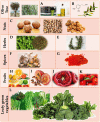Applications of Plant Bioactive Compounds as Replacers of Synthetic Additives in the Food Industry
- PMID: 38201075
- PMCID: PMC10778451
- DOI: 10.3390/foods13010047
Applications of Plant Bioactive Compounds as Replacers of Synthetic Additives in the Food Industry
Abstract
According to the Codex Alimentarius, a food additive is any substance that is incorporated into a food solely for technological or organoleptic purposes during the production of that food. Food additives can be of synthetic or natural origin. Several scientific evidence (in vitro studies and epidemiological studies like the controversial Southampton study published in 2007) have pointed out that several synthetic additives may lead to health issues for consumers. In that sense, the actual consumer searches for "Clean Label" foods with ingredient lists clean of coded additives, which are rejected by the actual consumer, highlighting the need to distinguish synthetic and natural codded additives from the ingredient lists. However, this natural approach must focus on an integrated vision of the replacement of chemical substances from the food ingredients, food contact materials (packaging), and their application on the final product. Hence, natural plant alternatives are hereby presented, analyzing their potential success in replacing common synthetic emulsifiers, colorants, flavorings, inhibitors of quality-degrading enzymes, antimicrobials, and antioxidants. In addition, the need for a complete absence of chemical additive migration to the food is approached through the use of plant-origin bioactive compounds (e.g., plant essential oils) incorporated in active packaging.
Keywords: active packaging; natural antimicrobials; natural antioxidants; natural colorants; natural emulsifiers; natural flavorings; plant bioactives.
Conflict of interest statement
The authors declare no conflict of interest. The funders had no role in the design of the study, the collection, analysis, or interpretation of data, the writing of the manuscript, or the decision to publish the results.
Figures




References
-
- Gooderham N.J., Cohen S.M., Eisenbrand G., Fukushima S., Guengerich F.P., Hecht S.S., Rietjens I.M.C.M., Rosol T.J., Bastaki M., Linman M.J., et al. The safety evaluation of food flavoring substances: The role of genotoxicity studies. Crit. Rev. Toxicol. 2020;50:1–27. doi: 10.1080/10408444.2020.1712589. - DOI - PubMed
-
- McCann D., Barrett A., Cooper A., Crumpler D., Dalen L., Grimshaw K., Kitchin E., Lok K., Porteous L., Prince E., et al. Food additives and hyperactive behaviour in 3-year-old and 8/9-year-old children in the community: A randomised, double-blinded, placebo-controlled trial. Lancet. 2007;370:1560–1567. doi: 10.1016/S0140-6736(07)61306-3. - DOI - PubMed
Publication types
Grants and funding
LinkOut - more resources
Full Text Sources

